
How to Stop Google Chrome from Tracking Your Location On Lava Yuva 3? | Dr.fone

How to Stop Google Chrome from Tracking Your Location On Lava Yuva 3?
Do you know your web browser is continually sharing your actual location online? You might not have noticed, but the number of websites using your location has increased. As you are well aware of the dangers of the internet, it doesn’t make sense to turn your Chrome into a beacon for ill-intentioned people. Luckily, it is possible to fake a location on Chrome with the right tool.
Are you wondering how to fake the browser location or which tool to use? You can get all your answers by reading this article till the end.

Part 1: How Does Chrome Know Your Location?
Before discussing Google Chrome’s fake location, it is important to know how Chrome detects your physical location. Google Chrome uses many ways to pinpoint your exact location, like your IP address, GPS, Wi-Fi, Bluetooth, and Cell Tower data. Every internet connection has an IP address bound to a location that enables Chrome to identify your location.
Similarly, GPS location can easily be tracked if your phone device has it enabled. All the Wi-Fi and Bluetooth connections around you also have location information embedded in them. They can help Chrome track you as long as your device can detect them. If you use cell data, Google Chrome can also track you through cell towers.
Part 2: How to Hide Location Services in Chrome?
If you are worried about Google Chrome detecting your physical location and sharing it with websites and apps, you can hide it easily. The process of hiding your location on Google Chrome is simple, even if you are using multiple devices. Below is the step-by-step process of hiding location services in Google Chrome on computer, Android, and iOS devices.
Method 1: For Laptop and Desktop PCs
Step 1: Launch Google Chrome on your computer and click the “Three Dots” icon to open the Google Chrome Settings. Here, tap “Privacy and Security” from the left sidebar and select “Site Settings.”

Step 2: Navigate to “Permissions” and click on “Location.” To hide the location on Google Chrome, select the “Don’t allow sites to see your location” option.

Method 2: For iPhone or iPad
Step 1: Navigate to “Settings” on your iPhone and open it. Scroll down until you find the “Chrome” app option and select it.

Step 2: Press “Location” on the next screen to open the location options for Google Chrome. Here, choose “Never” to stop Google Chrome from detecting your location.

Method 3: For Android
Step 1: Open Google Chrome on your Lava Yuva 3, press the “Three-Dots” icon, and tap “Settings” from the options.

Step 2: In Chrome Settings, press “Site Settings.” Now select “Location” and hide your location by toggling off the “Location” option.

One way to protect your privacy and stop websites from tracking your location is to turn off the location, but it has many disadvantages. If you have turned off your location, you can’t use any location base service like food delivery, e-shopping, ride-sharing, etc. That’s why it is better to use a fake location on your browser. Below we have explained four methods for Chrome fake location.
Method 1. Best Tool to Fake Chrome Location On iOS and Android Phones
The easiest and quickest way to fake your location on Google Chrome is to use Dr.Fone - Virtual Location . Since smartphones contain a wide range of apps that require location access, it provides a stable way to fake Chrome locations on Android and iOS phones. No website or app will be able to detect that you are using a fake location when using Dr.Fone - Virtual Location for faking GPS location.
Key Features
- Dr.Fone - Virtual Location can be used for any social media app like Facebook, Twitter, or Instagram with a fake location.
- With the help of this tool, you can also spoof real-time tracking apps like Life360 to protect your privacy.
- If you are an iPhone user, you don’t have to jailbreak your iPhone to spoof your device’s location.
How to Fake Chrome Location On iOS/Android Phones via Dr.Fone - Virtual Location
Faking your Chrome location with Dr.Fone - Virtual Location is very straightforward. You only need the Dr.Fone mobile toolkit and a USB cable to connect your Lava Yuva 3. Follow these steps to spoof Chrome location on Android and iOS phones:
Step 1: Connect Your Android/iOS Device to Your Computer
Connect your Android or iOS phone to your computer using a USB cable. Launch the Dr.Fone robust toolkit on your computer and select “Virtual Location.”

Step 2: Activate the Teleport Mode
Press “Get Started” on the next page to open the map window. First, select your actual location by pressing the “Center On” icon from the right sidebar. Afterward, click on the “Teleport” icon from the top right corner to activate the Teleport Mode.
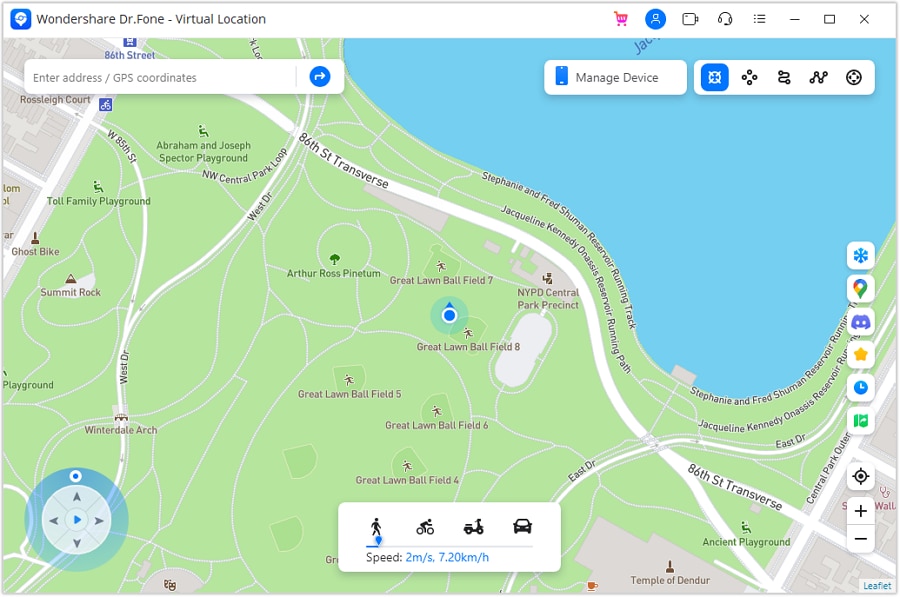
Step 3: Add the Desired Fake Location
Once the Teleport Mode is activated, add your desired location and press “Go.” Your desired location will open on the map. Select it, and a pop-up window will appear where you need to press “Move Here.” With that, your Android or iPhone’s Chrome location has been changed.
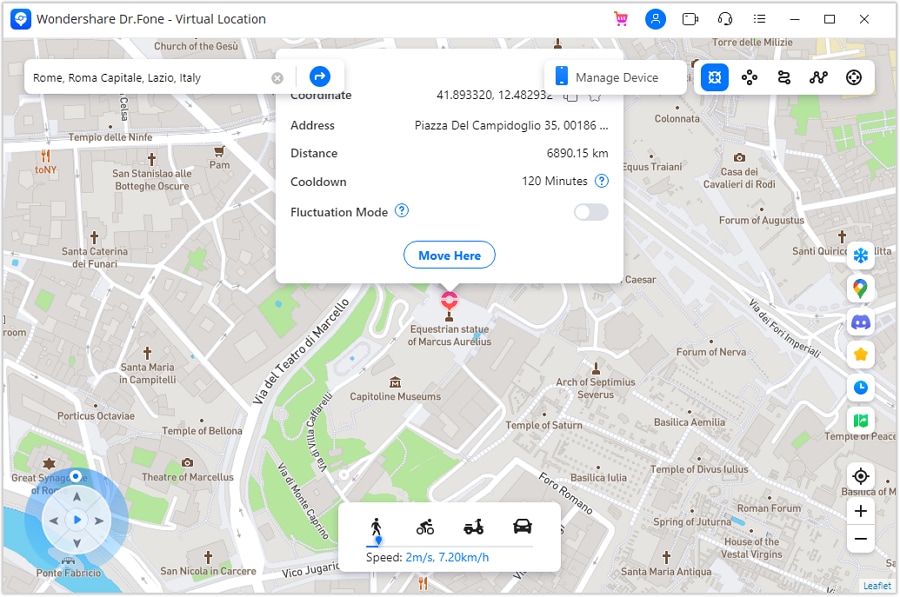
Method 2. Manually Change Your Location Using Google Chrome DevTools
It is also possible to fake browser location on Chrome using the Google Chrome Developer Tools. It is a built-in feature of Chrome and can be used to manually change or turn off your browser’s location. Follow these steps for changing location on Chrome with DevTools:
Step 1: After opening Google Chrome, click the three-dots icon from the top right corner. It will open the Chrome menu where you need to select “Developer Tools” after clicking “More Tools.”

Step 2: A window will open on the right side with all the developing tools you can use in Chrome. Click on the three-dots icon located near “Console” in the bottom left corner of the window. Choose “Sensors” from the pop-up menu.

Step 3: Access the newly selected “Sensor” option, and here you can change the browser’s location by either selecting a Google’s pre-set location or adding your desired location manually. Once the location is selected or added, your browser’s location will change.

Limitations
- The interface of the Google Chrome DevTools can be very confusing and overwhelming for non-technical users.
- Apart from pre-added locations, it can be hard to add a specific location as your fake location.
Method 3. Fake Your Location Using Chrome Extension
Many fake location Chrome extensions are available on Google Chrome which can be used to alter your location on Chrome. You can find these extensions on Google Chrome Web Store and add them directly to your browser. Below we have explained the steps for using such an extension “Location Guard “ to fake your location on Google Chrome:
Step 1: Open the “Location Guard” on Chrome Web Store and click “Add to Chrome” to add it to your browser. Once the “Location Guard” extension is added, open it and press “Options.”

Step 2: In the options, you can choose different options like Privacy Levels, Protection Area, and Time for Location Cache. It is recommended you choose a higher level for more protection.

Step 3: You can also use the “Fixed Location” feature to set up a fake location as a permanent location for your browser. The fixed location can be added by using the market or clicking on the desired place on the map.

Limitations
- Location Guard doesn’t protect your IP address. It means some websites can still detect your real location using the IP address.
- The app is not updated for quite a while, that’s why the map of the fixed location feature is quite restricted.
Method 4. Spoof Your IP Using a VPN Server
Another way you can fool websites and your browser by displaying a fake location online is to use a VPN server. VPNs fake your IP address to fool websites and apps into detecting your location. NordVPN is a VPN that can be used to spoof your IP by following these steps:
Step 1: Download and install NordVPN on your computer or phone and log in using your account. If you don’t have a NordVPN account, you must create one first.
Step 2: If you want to just change the location of your device, you can select “Quick Connect.” Using it will enable the program to automatically find the most suited fake location for you.

Step 3: You can also choose the desired location as your fake Chrome location in NordVPN. To do that, scroll down the list of countries and locations and choose your desired locations to connect to.
Limitations
- NordVPN can only spoof your IP address and will not work for geo-restricted applications.
- Using a VPN usually affects your internet speed and can make browsing slower and more difficult.
Part 4: FAQs
1.What is Geolocation?
Geolocation is a term used for the process of pinpointing the location of a device connected to the internet. The location can be determined using methods like IP address, GPS, and mobile tower data. Apps and websites commonly use it to provide location-based services.
2.What is the HTML5 Geolocation API?
The HTML5 Geolocation API is a browser API used to determine a user’s geographical location. Developers use it to build location-aware websites and apps that use users’ locations as the basis for providing their services. It can detect location through GPS, Wi-Fi, Bluetooth, IP addresses, etc.
3.Why should you hide or spoof your Location?
Hiding or spoofing your location protects your privacy and stop application and websites from tracking you. It also allows you to access geo-restricted apps and play location-based games. You can also fake your location to get the latest updates of your favorite apps.
Conclusion
The fact that Google Chrome in your devices can track your location with an accuracy of up to 20 meters is very unsettling for users. Even when you try to be careful in granting location permissions to apps and websites, many can still bypass this by adding location access requirements in terms and conditions.
That’s why having a tool like Dr.Fone - Virtual Location to fake GPS online is essential nowadays. It can ensure your privacy and helps in protecting you from the dangers of the internet.
Is pgsharp legal when you are playing pokemon On Lava Yuva 3?
Pokémon Go is the phenomenon that hit us in 2016 and made us obsessed with the AR game based on real-time location. If you are one of those players who have been to all the local PokeStops in hopes of finding your favorite rare Pokémon, then it might be time for you to consider spoofing your location while playing PoGo.
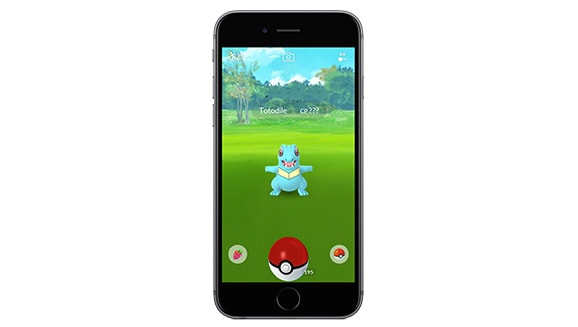
Pokémon Go relies on GPS coordinates and real-time tracking to let players catch Pokémon s in real locations. Hence, spoofing comes to the discussion of “catching them all.”
‘Spoofing’ location makes your phone, and thereby the game thinks that you’re in another location, which opens up the possibility to catch new and rare Pokémon s from gyms and PokeStops around the world.
Part 1: Is Pgsharp legal?

No game developer likes to see their game played in unfair ways. Thus, Niantic (PoGo’s Dev) made some strict rules against exploiting their game, giving some players an unfair advantage over others.
So, is PGSharp legal? No, Spoofing location, in general, is illegal. Hence, any apps like PGSharp, or Fake GPS Go, used to disguise actual real-time location and fake it, will result in an account ban.
According to Niantic’s terms and conditions:
- “Using any techniques to alter or falsify a device’s location (for example through GPS spoofing).
- And _”_Accessing Services in an unauthorized manner (including using modified or unofficial third party software).”
If Niantic detects usage of a fake location or GPS spoofing app while playing Pokémon Go, they will impose a strike on your account.
- The first strike would make rare Pokémon s not visible to you for seven days.
- The second strike would temporarily ban you from playing the game for 30 Days.
- The third strike will permanently ban your account.
You can appeal these strikes to Niantic if you think you’ve been banned without violation of any terms.

Part 2: Three ways to spoof on Android
- PGSharp :

PGSharp is one of the most reliable ways to spoof your location while playing Pokémon Go. Niantic does not easily recognize its simple map-like UI as a fake location app.
Note: It is recommended not to use your main account while spoofing; rather, you should use your PTC (Pokémon Trainer Club) account.
- To spoof the location with PGSharp, go to Google’s “Play store,” search “PGSharp,” and install it.
- After installation, there are two versions: Free and Paid. For trying the app with the free version, a beta key is not required anymore, while for the paid version, a key from the developer is required.
- For the paid key, visit PGSharp’s official website and generate a license key.
You must note that it may take two or more tries to generate a working key, and often it may show an “out of stock.” message.
- After opening the app and applying the key, you can spoof the location with ease.
Note: You may need to allow “Mock location” from debugging options. For this, go to “Settings,” then to “About Phone,” then you need to tap on “Build number” seven times to enable developer’s mode, and finally go to “Debugging” to allow “Mock location.”
- Fake GPS Go:
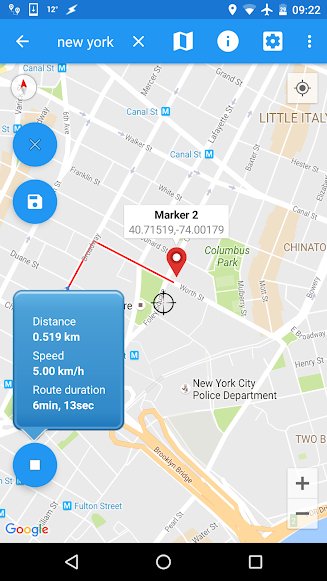
Fake GPS Go is another location spoofer app for Android that is reliable and free. This app allows you to fake your real-time location and enables you to spoof it to any place in the world. This is one of the easiest solutions to playing Pokémon Go while spoofing location without getting detected with its real-map-like UI. Moreover, this app does not even require root access.
- To install Fake GPS Go, go to Google’s “Play store,” search “Fake GPS Go,” and install it.
- Then, go to your phone’s “Settings” and then “System” followed by “About Phone,” and tap on the “Build Number” 7 times to enable the Developer Options.
- Then you need to go to “Debugging” in “Developers Options” to allow “Mock location.”
- And then, you can use this app to not only spoof your location but virtually walk around a route at a designated pace to make it look as real as possible for being undetected by developers like Niantic.
- VPN:

Using a Virtual Private Network (VPN) App is the safest option to spoof your location while playing PoGo, as it masks your IP address and uses a server in any other location.
Moreover, some VPNs would also encrypt your data, so it would not be easy for Game Devs to track it.
- To install a VPN, go to Google’s “Play store,” search the VPN of your choice and install it.
- Close the Pokémon Go app from running in the background to prevent detection of the VPN.
- Now, select a location server to any place before opening the PoGo app again.
Note: Some Free VPNs only mask your IP address and do not spoof your location, nor do they encrypt your data. Hence, selecting a good VPN app is imperative, which will spoof GPS location and data encryption.
You can use both VPNs (which do not spoof GPS location themselves) and the Fake location app simultaneously for extra reliability.
Part 3: Best way to spoof on iOS – dr.fone Virtual Location
Spoofing the GPS location on iPhones is more difficult and much more complex than it is on Android. However, there is a solution. Dr.Fone comes to the rescue with their Virtual Location tool that works seamlessly. This program is easy to use and allows you to simulate your location between 2 and multiple spots with ease. Apart from that you can teleport anywhere with ease. Let us know how this tool works.
Step 1: Download the tool on your PC from the official website of drfone. Select “Virtual Location” given on the first page of the program.

Step 2: Now, have your iPhone connected to your computer. Then select “Get Started”. Now a map will open in a new window, showing your actual location.
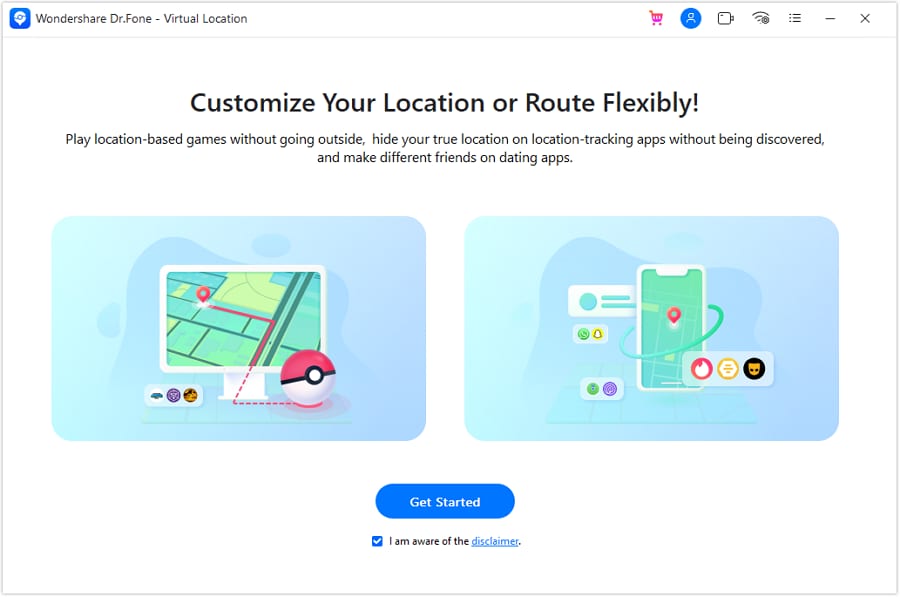
Step 3: Enable the “teleport mode” by the third icon in the right-upper corner of the map. Then, enter the location you want to spoof your phone’s GPS to in the text box in the map’s left-upper section. Select “Go”.
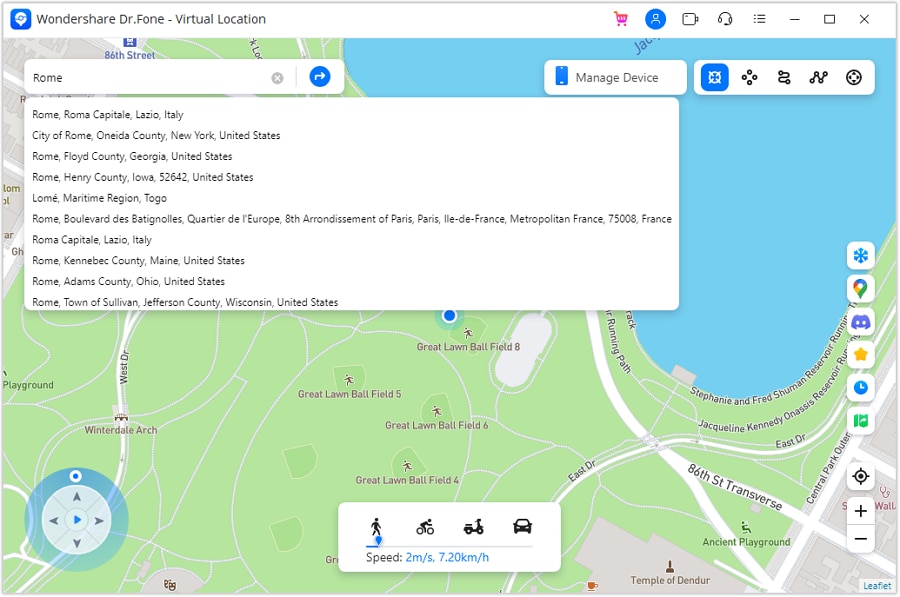
Step 4: Now select “Move here.” And you will have successfully spoofed your location on your iOS device. To confirm, open the maps app on your device.

Pro-Tips:
- Do not spoof or change location very frequently, as this might raise suspicion to the Game Dev (Niantic), and the account may get terminated, stating violation of terms.
- Do not use spoofing too frequently. The best way to not get your account suspended is to replicate actual travel patterns.
- Please select a new spoof location and scout it for a couple of days before going to a close-by spoof location. After you are done with the country in the spoof-location, you can move on to neighboring countries before returning to your original location (i.e., switching off the spoof.)
- After you are done with your gaming, always remember to close the game from the background before turning off the spoof location.
- Do not always play with the spoof location. Play with your original location for a couple of weeks before spoofing your location.
- Do not spoof location to countries on different continents within a short time.
Following these tips will help you to behave like an actual traveler who’s on a Pokémon hunt. This will make it even harder for game devs to detect any discrepancies.
Prevent Cross-Site Tracking on Lava Yuva 3 and Browser
Have you ever wondered why you get the advertisements of the websites you visited a few minutes ago on your social media sites? Here comes to Cross-Site Tracking, also termed CST, and it is a process where third-party cookies and sites track your browser history.
![]()
The CST process is like invading your privacy by collecting your browser history and personal information. So, to prevent these services, there are several ways by which you can cross-site tracking on your system as well as Lava Yuva 3 phone browsers. Keep reading to learn how to stop cross-site tracking on both Lava Yuva 3 and browser.
Part 1: Why Do We Need to Stop Cross-site Tracking?
Cross-site Tracking is all about collecting your browsing data and other information for advertising purposes. Though the process can prove convenient for many as it provides additional information about the products and services you have searched for and offers tailor-made content, it is intrusive and about breaching your privacy.
Cross-site tracking collects information about your browsing history. The third-party cookies also monitor the content type you have visited and your personal information, which is risky.
Besides invading privacy, the CST also poses several other issues. Based on your browsing history, additional content you have not asked for is loaded on your visited sites, slows down the page loading process, and puts an extra burden on your battery. Moreover, too much-unwanted content can interfere with the basic information you are looking for.
So, it is always better to prevent cross-site tracking for all the above and more reasons.
Further reading: A detailed guide on faking location in Mozilla Firefox . Don’t worry about your location privacy anymore!
Part 2: Can Private Browsing be traced?
Yes, private browsing can be traced. When you work in private browsing mode, the web browser does not save the browsing history, which means that anyone who uses your system will not check your online activities. But websites and cookies can track your browsing history as well as other information.
Part 3: How to Disable Cross-website Tracking on Safari for iOS Devices?
Safari is the most commonly used platform by iOS users. So, to prevent CST for Safari on your iOS devices and Mac systems, below is a complete guide.
Deactivate Safari cross-website tracking for iPhone & iPad
Safari cross-site tracking can be prevented using the below steps on your iPhone and iPad.
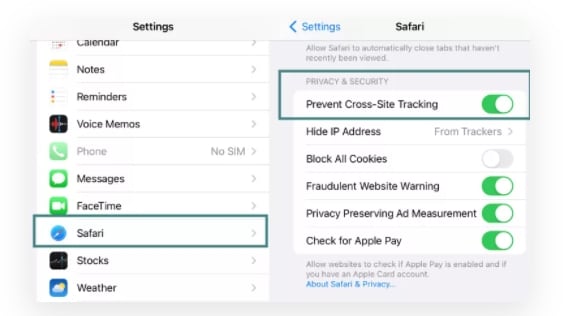
- Step 1. Launch the Settings app on your iOS device.
- Step 2. Find the Safari option by scrolling down the menu.
- Step 3. Move the slider to turn on “Prevent Cross-Site Tracking” under the PRIVACY & SECURITY option.
Deactivate Safari cross-website tracking for Mac
Use the steps below to turn off cross-site tracking on Safari on your Mac systems.

- Step 1. On your Mac system, open the Safari app.
- Step 2. Move to Safari > Preferences > Privacy
- Step 3. Enable the “Prevent cross tracking” option by clicking on the box next to it.
Part 4: How to Disable Cross-site Tracking on Google Chrome
Chrome is used widely on Windows systems and Android devices, and to prevent the CST from your browser, a detailed guide is given below.
Enable “Do Not Track” on Google Chrome for Android
- Step 1. On your Lava Yuva 3, open the Chrome app.
- Step 2. At the right side of the address bar, click on the More option and choose Settings.
- Step 3. Choose the Privacy option from the Advanced tab.
- Step 4. Click on the “Do Not Track” option to turn on the feature.

Enable “Do Not Track” on Google Chrome for Computer
- Step 1. Launch Chrome on your system, and from the menu at the upper-right corner, click on the Settings option.
- Step 2. From the “Privacy and Security” tab, choose the “Cookies and other site data” option.
- Step 3. Tap and enable the slider next to “Send a “Do not track” request with your browsing traffic.”
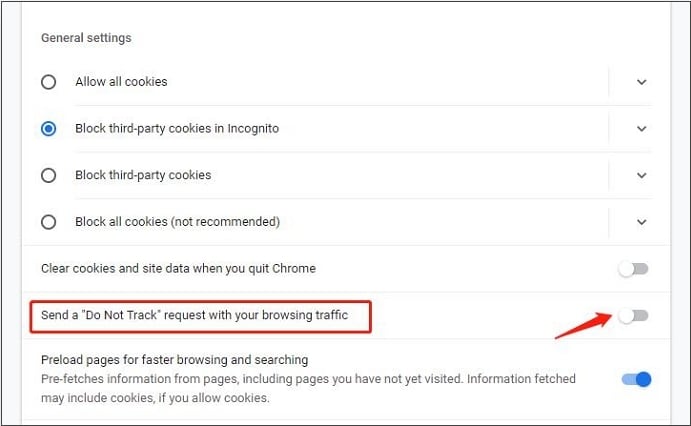
Part 5: Recommended Solution: Fake a Location to Stop Cross-Site Location Tracking Using Dr. Fone
What if you let the sites and cookies track your phone location without worrying about your privacy? Yes, it can be done by spoofing your location. So, if you set a fake location while browsing the internet, you will not have to worry about cross-site tracking, as anyways, the sites and cookies will get misled browsing information that cannot harm you in any manner.
Setting a fake location on your iOS devices, a professional tool is needed, for we recommend Wondershare Dr.Fone - Virtual Location as the best tool. Using this Android and iOS-based software, you can set any fake GPS location on your device. The tool is simple to use and does not require any mastery of technical know-how.
Key features
- Simple tool to teleport to any GPS location in a single click.
- Allows simulating GPS movement along the route.
- All popular models of Android and iOS devices are compatible.
- Compatible with all location-based apps on your phone.
- Compatible with Windows and Mac systems.
Here is a video tutorial for you to take an overview of how to use Dr.Fone - Virtual Location to fake location on your Android and iOS devices.

Steps to set fake location on your Android and iOS devices using DrFone-Virtual Location
Step 1. Download, install and launch the software on your Windows or Mac systems. On the main software interface, choose the Virtual Location option.

Step 2. Connect your iPhone or Android device to your system using a USB cable and then tap on the Get Started option on your software interface.

Step 3. A new window on the software interface will open, showing your connected phone’s real and actual location. If the detected location is incorrect, click on the “Center On” icon to display the right device location.

Step 4. Next, you need to activate the “teleport mode” and click o the 3rd icon at the upper-right corner.
Step 5. Next, you have to enter now the fake location to which you wish to teleport to at the upper-left corner. Click on Go.

Step 6. Finally, tap on the Move Here button and the new fake location for your connected Android or iOS device at the pop-up box.

Check the new location of your phone from the app.
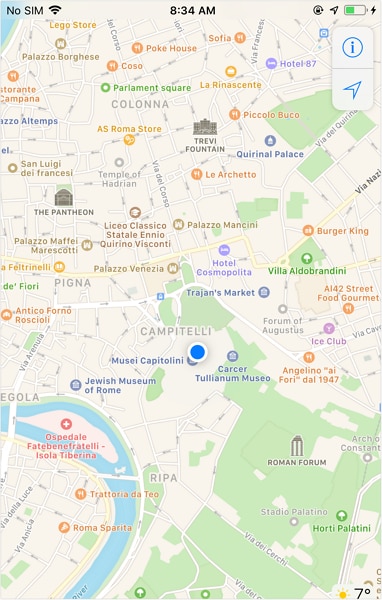
Wrap it up
Preventing Cross-site tracking can be done on different browsers and devices using the guides listed in the above parts of the article. Settings a fake location for your device using Dr. Fone-Virtual Location is another interesting way to prevent tracking your browsing history by spoofing the sites and cookies. Setting a fake place will not only avoid monitoring your browsing history but will also work with all location-based apps on your phone.

Also read:
- '21 Vegas Pro's Impact on Sports Betting Analysis for 2024
- 2024 Approved Logo Luminosity Enhancing Gaming Channels with Designs
- 2024 Approved Restoring MacOS Sierra to OS X 10.10.1 Environment
- All Must-Knows to Use Fake GPS GO Location Spoofer On Vivo T2 5G | Dr.fone
- Best 10 Mock Location Apps Worth Trying On Infinix Note 30 | Dr.fone
- ChatGPT's Literary Evolution: Personalizing Prose
- Fixing Foneazy MockGo Not Working On Huawei Nova Y71 | Dr.fone
- How to Reset Gmail Password on Tecno Pop 7 Pro Devices
- In 2024, Epic Quests Unveiled Top Games Mirroring Ghost of Tsushima
- In 2024, How Can You Transfer Files From OnePlus Nord CE 3 Lite 5G To iPhone 15/14/13? | Dr.fone
- Prank Your Friends! Easy Ways to Fake and Share Google Maps Location On Samsung Galaxy M34 | Dr.fone
- The Best Android SIM Unlock Code Generators Unlock Your Meizu 21 Phone Hassle-Free
- Ultimate Guide to Free PPTP VPN For Beginners On Motorola Moto G04 | Dr.fone
- Ultimate Guide: Terminating Your Paramount+ Membership Seamlessly
- What are Location Permissions Life360 On Infinix Smart 8 HD? | Dr.fone
- What is Fake GPS Location Pro and Is It Good On Vivo Y78 5G? | Dr.fone
- Title: How to Stop Google Chrome from Tracking Your Location On Lava Yuva 3? | Dr.fone
- Author: Ava
- Created at : 2024-11-10 16:41:18
- Updated at : 2024-11-12 16:25:00
- Link: https://fake-location.techidaily.com/how-to-stop-google-chrome-from-tracking-your-location-on-lava-yuva-3-drfone-by-drfone-virtual-android/
- License: This work is licensed under CC BY-NC-SA 4.0.